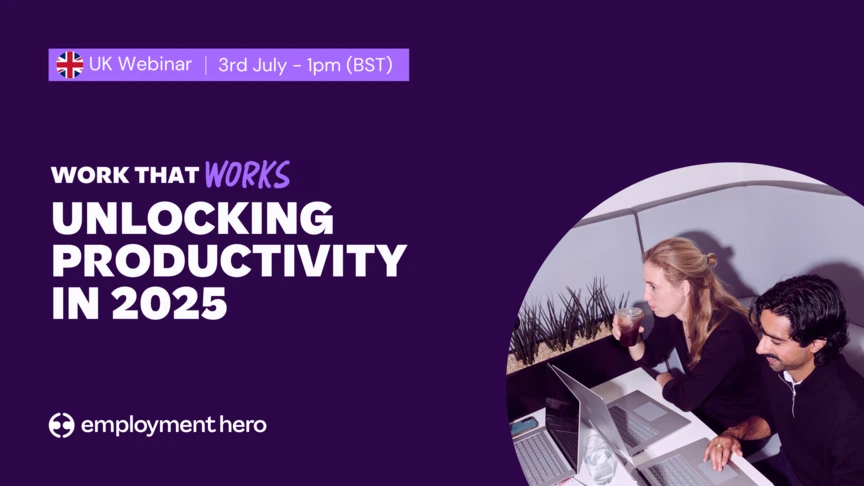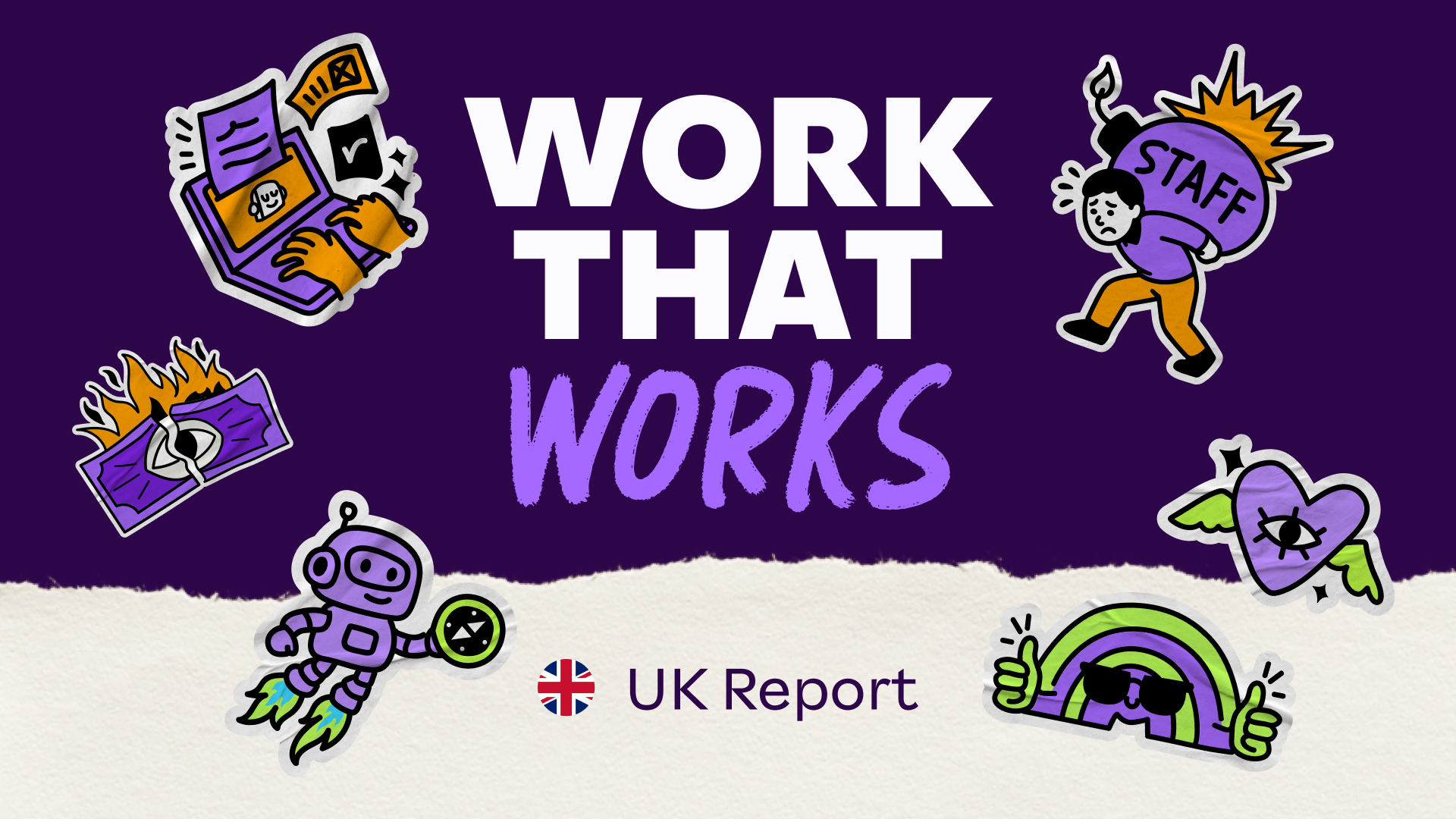Ultimate Free One on One (1:1) Meeting Template + Guide
Published
Ultimate Free One on One (1:1) Meeting Template + Guide
Implementing 1:1 meetings can be the difference between building a good team and a great team. If you’re ready to reap the benefits of 1:1s, this guide is for you. Discover how effective 1:1s boost employee engagement, strengthen communication, and drive productivity across your organisation.
Whether you’re starting your first one to one meeting or looking to optimise your existing manager’s meeting process, this guide and free template will help you cover the right talking points, helping keep each session focused and productive.
What’s in the guide?
- The foundations of internal communication
- Decoding 1:1s: what they are and why they matter
- How to run an effective 1:1
- The art of feedback
- Elevating engagement and career development
- The power of flexibility in 1:1s
What does this template include?
The one on one meeting template has editable sections that can be customised to your company’s needs. It can be used as a meeting agenda template, as it includes some sample questions you can ask during your next meeting with your team member. These questions are focused on gauging employee engagement and probe further discussion to aid career development for your direct report.
Our template helps both the manager and employee set top priorities, reflect on the week ahead and track current projects. It also includes structured sections to share feedback, log status updates, and guide goal setting discussions.
Consider adding prompts that emphasise well-being, for example, “How have you been feeling lately?” or “What’s something you’re proud of this month?” These prompts can help build trust and create opportunity for personal wins and challenges, not just performance.
Additionally, it can be hugely beneficial to use the template to support joint ownership between manager and employee. Allow employees to add their own agenda items ahead of time and include room for mutual feedback, such as “What can I do better as your manager?”
This collaborative approach allows both parties to exchange feedback effectively, to a consistent meeting structure that can boost engagement over time.
What are 1:1s?
Effective 1:1s contribute to all of the elements of improving employee performance. It allows for:
- A safe communication space
- Career discussions
- Linking to broader organisational goals
- Space to check-in
- Relationship building
- Idea sharing
- Listening
- Feedback
This one meeting creates a safe space for open communication that moves beyond the status quo and enables alignment.
A 1:1 is a scheduled meeting in your calendar and in your mental map for open-ended and anticipated conversation between a manager and an employee. Unlike status reports or tactical meetings, a 1:1 meeting is a place for coaching, mentorship, giving context or even venting. The 1:1 goes beyond an open door policy and dedicates time on a regular cadence for teammates and leaders to connect and communicate.
Each employee’s meeting can be tailored using this downloadable template to ensure consistency and structure while remaining flexible to individual needs.
Why are 1:1s so important?
1:1s can strengthen the relationship between managers and their team, reduce turnover and increase productivity. For 1:1s to be as effective as possible, they should adhere to three key things:
- Scheduled
- Recurring
- Structured
Not only do 1:1s serve to strengthen professional relationships, they contribute to improved communication and trust within the business, a great benefit for any workplace. By having a transparent relationship with your direct report(s), you’ll be able to understand how they’re feeling. Whether they’re feeling anxious about an upcoming project or need some assistance with a task, 1:1s help you as a manager support your team.
Bi-weekly meetings or regular check-ins also give managers the opportunity to celebrate wins and identify blockers before they grow. A strong meeting structure built around status updates and feedback loops can dramatically improve your outcomes.
Consider making time in your meetings to check on employee well-being and stress levels more intentionally. Simple questions such as “How have things been for you outside of work?” can open up more holistic discussions that prevent issues from snowballing.
Additionally, 1:1s aren’t just for determining roadblocks or challenges in the workplace. Use this time to find out if your direct report(s) are feeling happy, inspired and engaged with their work. This is important for managers for them to manage their direct report(s) effectively and put strategies in place if something requires attention.
When employees feel heard and supported, it creates the right channels for stronger relationships to form, and helps improve team culture.
Before we continue, ask yourself these two questions.
- When was the last time you checked in with your direct report(s)?
- How do you effectively manage someone you aren’t regularly checking in with?
Let’s take a look at this scenario:
Your direct report is completing great work, so you assume they’re loving their role. However, one month later they resign from their role and you feel blindsided and confused. You assumed that they were working long hours because they loved what they were doing; however, this was not the case. In the exit interview, they reveal that they were feeling extremely burnt out and underappreciated in their role, so when the opportunity came about to jump ship, they did.
We’ve all seen this scenario time and time again, and it’s something that we believe can be avoided with better communication. If you knew that your direct report was feeling under-appreciated, you could have taken the appropriate action to reward and recognise their efforts. If you knew that they were feeling burnt out, you could have reduced their workload, expanded the team or encouraged them to take leave. At the end of the day, poor communication can be detrimental to business success. To decrease your risk of losing top talent, we suggest that you implement 1:1s, pronto!
How to run an effective 1:1
A well-structured approach can greatly enhance the effectiveness of one-on-one meetings. Following these steps will ensure your sessions are productive and meaningful.
Step 1: Prepare in Advance
Effective preparation is essential. Both parties should come with a meeting agenda that includes topics, questions, and updates on previous action items. For a first-time one-on-one, set a welcoming and respectful tone that encourages openness. For recurring meetings, review past notes to track progress and ensure a focused discussion.
Use a meeting template to streamline preparation and ensure every talking point is covered without missing key updates or next steps.
To create a sense of shared ownership, invite your direct report to contribute agenda items in advance. A collaborative doc or shared platform can help make this process seamless.
For example, an HR manager could review the employee’s recent performance data, highlight areas for discussion, and prompt the employee to reflect on their challenges and accomplishments.
Step 2: Create a Comfortable Environment
Ensuring your team member feels comfortable during a 1:1 plays a key role in its success. This applies to both in person and remote businesses.
In person: Opt for a quiet, private space to maintain confidentiality and avoid distractions. For instance, a supervisor might book a conference room or suggest a walk outside to create a relaxed, open environment conducive to candid conversation.
Remote: People are usually more comfortable in their own home, so it can be slightly easier to make people feel relaxed during remote 1:1 meetings. To create a more relaxed atmosphere, supervisors can also suggest “coffee and chat” or walking meetings. But make sure to book a time in your team members calendar when they are free, and try to avoid back to back meetings so they aren’t rushing to their next call.
Step 3: Encourage Open Discussion and Active Listening
Start by reviewing the meeting agenda, then dive into key discussion points. Encourage open dialogue by asking open-ended questions and listening attentively to the responses. A manager might ask, “What support do you need to reach your current goals?”
Also consider questions that reflect the human side of work — such as “What’s something you’re excited about right now?” or “Is there anything that’s been weighing on you?” These kinds of conversations can help build connections in your 1:1s.
Don’t skip the small talk – it can often lead to open conversation and reveal concerns or opportunities you wouldn’t have otherwise uncovered.
This promotes a two-way conversation and shows that the employee’s input is valued.
Step 4: Recap and Define Action Items
Conclude the meeting with a summary of the key points discussed, agree on actionable next steps, and set deadlines for any tasks.
To deepen engagement and accountability, introduce a shared notes section where both parties can document action items and leave comments. This supports transparency and makes follow-up easier between meetings.
For example, if an employee is interested in further professional development, the manager could assign them to explore available courses and schedule a follow-up meeting to decide on next steps for enrolment.
Use this moment to check progress against agreed goals and ensure alignment with individual career goals and broader business objectives.
What questions could you ask in a 1:1?
It’s important to have a list of questions ready for your 1:1. If possible, ask your direct report(s) to fill them out before your meeting so that you can both come prepared. This will make sure that you stay on track and get the most out of your session.
To support reflection and development, try including questions like: “What’s something you learned this month?”, “What challenges have you faced lately?” or “How can I support you better?”
The benefits of 1:1s
The benefits of a 1:1 are numerous and have a significant impact on both individuals and the overall team dynamics within an organisation.
They can be especially impactful for onboarding a new employee, helping them build confidence and understand their role from day one. Here are some key benefits of conducting regular 1:1 meetings:
Improved communication
1:1s provide a dedicated space for open and honest communication between a manager and their team members. This creates transparency, trust and a deeper understanding of each other’s perspectives, leading to better collaboration and a smoother workflow.
The addition of real-time collaborative tools — such as shared notes or comment threads — can enhance this further by enabling continuous dialogue between meetings.
Increased employee engagement
Regular 1:1s demonstrate that managers value their team members’ input and well-being. This sense of support and attention to individual needs can significantly boost employee engagement and job satisfaction.
Enhanced productivity
By addressing challenges, roadblocks and concerns on time, 1:1s help remove obstacles that might hinder productivity. The meetings also serve as a platform for setting clear goals, aligning expectations and providing the necessary resources for success.
Building trust and professional relationships
The confidential and supportive environment of 1:1s encourages team members to share their thoughts, concerns and aspirations openly. This builds trust between managers and employees, fostering stronger professional relationships and loyalty to the organisation.
Career development and growth opportunities
1:1s offer a dedicated forum to discuss career aspirations, skills development and advancement opportunities.
You can take this further by encouraging your employee to reflect on their personal development goals — for instance, by asking: “What’s a new skill you’d like to develop this quarter?”
This proactive approach to career growth empowers employees to take charge of their professional development and helps keep valuable talent within the organisation.
Real-time feedback
1:1s facilitate ongoing feedback, enabling managers to provide timely guidance and recognition for accomplishments.
Introducing mutual feedback (e.g., “What can I improve in how I manage or support you?”) promotes psychological safety and continuous improvement on both sides.
Constructive feedback, when given promptly, helps employees make the necessary adjustments and improve their performance.
Alignment with organisational goals
During 1:1s, managers can make sure that their team members’ efforts align with the broader objectives of the organisation. This ensures everyone is working towards common goals, driving the overall success of the company.
Effective problem-solving
1:1s offer a platform to address and resolve issues, conflicts and concerns before they escalate. Managers can work collaboratively with team members to find effective solutions and prevent potential challenges.
Employee well-being
By actively listening to team members’ well-being and stress levels, managers can identify signs of burnout and take necessary measures to support their employees’ work-life balance and overall well-being.
Incorporating well-being questions as standard prompts can make this more consistent and proactive.
Continuous improvement
The flexibility and adaptability of 1:1s allows for ongoing improvement in communication styles, meeting formats and approaches to addressing individual needs. This iterative process makes sure that 1:1 meetings remain relevant and effective over time.
The art of feedback
Day-to-day feedback happens organically during conversations — for example: “Alex, I think you could improve your knowledge on this by speaking to Dave”. However, if you’re looking to give more structured feedback in real time but you can’t directly talk to the person, document it. Once documented in a central place, you can:
- Pick a time and a medium for feedback. There are certain types of feedback that you are best to give in a conversation (by video or in-person).
- Decide whether this feedback might be taken the wrong way if not given in a conversation.
Enhance 1:1s with Employment Hero
Embrace the potential of 1:1s to transform your team and drive business success. By implementing strong internal communication and running effective 1:1s, you’ll nurture engaged employees, boost productivity and create a thriving workplace culture.
But our Employment Operating System can do more than just 1:1s. Our platform takes the isolated elements of employment and integrates them into a seamless, human and AI-powered solution that empowers business leaders, HR professionals and employees alike.
Related Resources
-
 Read more: Work that Works: Unlocking Productivity in 2025
Read more: Work that Works: Unlocking Productivity in 2025Work that Works: Unlocking Productivity in 2025
3rd July, 2025 1:00pm BST UK productivity has been puzzling experts for years. But what’s really driving productivity in SMEs…
-
 Read more: What is Structured Workplace Learning? A Comprehensive Guide
Read more: What is Structured Workplace Learning? A Comprehensive GuideWhat is Structured Workplace Learning? A Comprehensive Guide
Published Updated Contents Structured workplace learning isn’t just about ticking boxes or sitting through dull training sessions. It’s about growing,…
-
 Read more: Work That Works: UK Business Productivity Report (2025)
Read more: Work That Works: UK Business Productivity Report (2025)Work That Works: UK Business Productivity Report (2025)
Discover Employment Hero’s 2025 Work that Works Productivity Report. Explore insights, trends & strategies to boost productivity in UK SMEs.…










